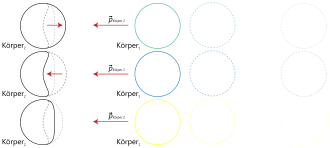Elasticity (physics)

Elasticity is the property of a body or material to change its shape under the action of force and to return to its original shape when the force is no longer applied (example: spring). One differentiates
- the linear-elastic behavior, which is described by Hooke's law , it generally occurs with small deformations, as well
- the non-linear-elastic behavior in which the stress depends non-linearly on the deformation. A typical example here is the rubber elasticity in the case of larger deformations.
If a deformation remains after removing the deflecting forces, this is called "elastic hysteresis ".
For all materials there is a limit to the elasticity range beyond which anelastic behavior is observed.
Mechanisms
If a force acts on a body, the equilibrium of its elementary building blocks ( atoms or molecules ) is disturbed. The distances between them are increased or decreased by a small amount, the mechanical energy used for this is stored and the workpiece changes its external shape. After the discharge , the atoms or molecules return to their original positions and the body assumes its original external shape. The energy for the deformation is only stored and released again when the load is removed.
If a certain value is exceeded when the force acts, a plastic deformation occurs in addition to the elastic deformation. This value depends on the material and is called the elastic limit . In the stress-strain diagram, it is the point from which a hysteresis occurs when the load is released. The voltage curve often deviates from the linear course here. However, this point is not clearly defined, but depends on the measurement method. Therefore, u. a. Often, a mandatory unambiguous assignment of bodies and materials to the properties elasticity and plasticity is not carried out, rather there is a combination of both properties or a change from elastic to plastic behavior depending on the extent, type and duration of the force.
Viscoelasticity is a special form of elasticity . It occurs primarily with polymers and is characterized by a partly elastic, partly viscous behavior. After removing the external force, the polymer relaxes only incompletely; the remaining energy is dissipated in the form of flow processes. Here, an increase in the elasticity means a decrease in the viscous behavior.
Applications
The linear-elastic behavior of some materials with small deformations is used for the construction and application of springs , see spring constant .
In engineering strength theory , more specifically in building construction and device engineering, the elastic properties of materials are used to ensure the dimensional stability of structures and devices under the action of force. With the calculation of the elasticity, a high load on load-bearing structures is achieved while avoiding the risk of breakage .
In order to be able to treat this computationally goal-oriented, the elasticity of materials is described in detail with:
- the modulus of elasticity ; it describes the relationship between tension and elongation during the deformation of a solid body with linear-elastic behavior.
- the compression module ; with its help it is calculated which all-round pressure change is necessary to cause a certain reversible volume change.
- the shear modulus ; it provides information about the linear-elastic deformation of a component as a result of a shear force or shear stress.
These three modules are linked to one another via the Poisson's number .
In rheology , linear elasticity is one of the three basic properties in addition to plasticity and viscosity and is represented in the rheological models by a spring, the Hooke element.
See also
- Textbook Solid Mechanics (English)
- Cause of the elasticity of elastomers on the subject of energy and entropy elasticity
- Beam theory
- Scattering (physics) of particles and / or quanta , which are described as elastic or inelastic
- Shock (physics)
- Elasticity theory
- Law of elasticity
- Cauchy elasticity
- Hypo-elasticity
- Hyperelasticity
literature
- Wilhelm Westphal : Physics. A textbook for students at universities and technical colleges. 2nd Edition. Springer, Berlin 1930.
- Ernst Grimsehl : Grimsehl textbook of physics. Volume 1: Mechanics · Acoustics · Thermal theory. 27th, unchanged edition. Teubner, Leipzig 1991, ISBN 3-322-00812-6 .
Web links
- Lexicon of Physics: Elasticity (accessed April 8, 2016)
- Elasticity and strength theory (accessed April 8, 2016)